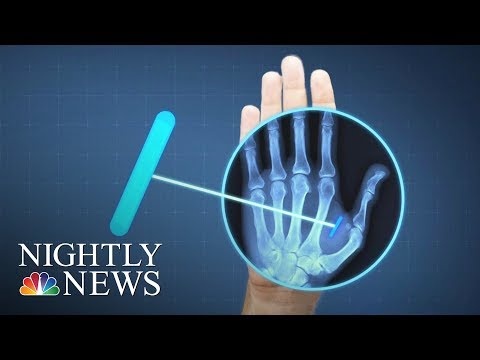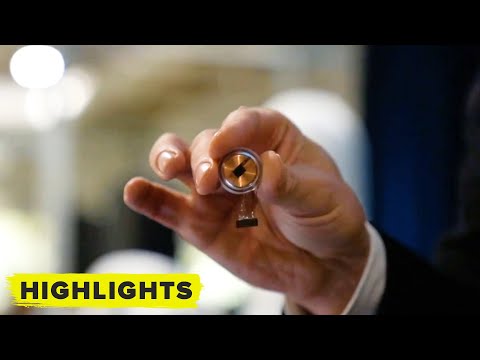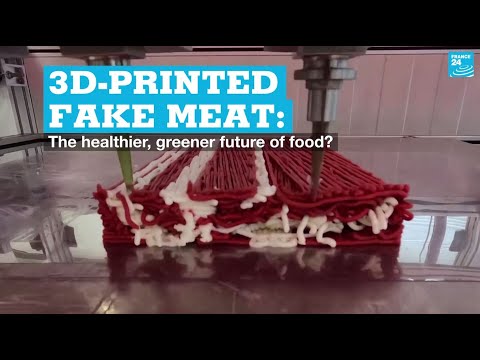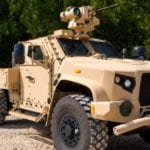Many of the horrors spawned from Philip K. Dick’s bustling, neon-lit streets are yet to come to fruition. But while the idea of android replicants and all-seeing pre-cogs may seem like a distant future, cyberpunk tech is gradually starting to take root. So let’s take a look at just some of the ways that society is embracing cyberpunk tech, for better or worse. 10 Ways Modern Technology Is Destroying Natural Selection
10 Beaming Ads from Space
Many companies are already leveraging a marketing tool known as “space advertising.” Since NASA’s decision to allow private flights to the International Space Station, PR opportunists have shuttled all manner of products to the orbiting research station, including Adidas soccer balls, bottles of wine, and shower heads. The Russians have even launched rockets plastered with ads for toothpastes, diapers, and TV networks. But now they want more. Imagine the night sky filled with a giant, luminescent brand advertisement – something billions of people will see (and cannot avoid). That’s the ambition of a Russian company called StartRocket. The startup aims to put a series of satellites in low Earth orbit, each fitted with a reflective solar sail. The orbital display is then generated when the Sun’s rays bounce off the satellite array. In 2019, the Russian arm of PepsiCo said it had struck a deal with StartRocket to devise a space billboard for one of its energy drinks, Adrenaline Rush. The idea was to launch a “campaign against stereotypes and unjustified prejudices against gamers.” The plans prompted an immediate backlash, however, and Pepsi was forced to respond. The drinks company said it had worked with StartRocket to test “stratosphere advertisements” using one of its logos but had no further plans to continue the project.[1]
9 Signing Virtual Influencers
Online influencers have one goal: advertize corporate swag for money. They use their lofty follower counts on Instagram and Snapchat to sign lucrative deals with big brands. The more followers, the better the pay. But Silicon Valley is starting to realize it can just “design” its own influencers in a digital laboratory. In 2016, a Los Angeles-based company, Brud, concocted a teen influencer named Lil Miquela. The CGI character immediately gained internet fame, attracting hoards of die-hard fans. Lil Miquela’s Instagram account is where the money is made. With nearly three million followers, the 19-year-old’s handlers have struck deals with a number of big names, including Calvin Klein, Prada, and Samsung. [LINK 3] In 2019, Lil Miquela featured in a commercial for Calvin Klein, in which she kisses American model Bella Hadid. She was even signed by the Creative Artists Agency (CAA) in 2020 – the agency’s first virtual client. Miquela claims to fight for social change, tackling issues on homelessness, racial equality, and LGBT rights. In 2018, Brud orchestrated an internet feud between Miquela and a digital pro-Trump influencer named Bermuda. The company made it seem as though Bermuda had hacked Miquela’s account and deleted all of her Instagram pictures. These types of stunts have paid dividends. To date, it is estimated that Brud has bagged a cool $6 million worth of investment.[2]
8 Electronic Tattoos
A number of researchers are hoping to use electronic tattoos (a.k.a. tech tats) as a means of gaining a foothold in the diagnostics industry. In April 2018, engineers at the University of Minnesota released a paper describing a method of applying 3D-printed electronics to a person’s skin. The team hopes the technology will deliver biomedical devices that can monitor a patient’s vital signs, including blood pressure, heart rate, and temperature. According to Professor Michael McAlpine, one of the paper’s authors, the tech tats have military applications, too. Given that the circuits can be constructed using a basic $400 printer, McAlpine predicts the tattoos will become commonplace in the field. “You can start to think about printing life-saving devices on the body, like a solar panel on the wrist, or a chemical or biological warfare sensor on an arm,” he explained. Meanwhile, a private company called Chaotic Moon aims to put the tech in the hands of the consumer. In 2015, the group’s hardware specialist, Eric Schneider, explained how his company’s tattoos would revolutionize the industry. “Rather than going to the doctor once a year to get a physical, this tech tattoo can be something you just put on your body once a year. And it monitors everything that they would do in a physical and sends that to your doctor.”[3]
7 Implanting Workers with Microchips
BioTeq, as part of its professional microchip service, has been implanting British workforces with radio-frequency identification (RFID) chips for years now. The tiny devices, which sit underneath the skin near the thumb, allow workers to open electronic doors, pay for cafeteria food, and log in to company computers – all with a wave of the hand. They can also hold small bits of data, including important medical information. Watch this video on YouTube A Wisconsin-based tech company, Three Square Market, has also chipped around half of its employees. Those who accepted the implants were awarded “I Got Chipped” t-shirts. The company president says he got the idea after a business trip to Sweden. Today, thousands of Swedes are volunteering to undergo the procedure. One of the country’s national railways allows passengers to pay for train tickets using the chip implants. Businesses and gyms use Near Field Communication (NFC) scanners to grant building access to tech-savvy citizens. And a number of vending machine companies have started rolling out the contactless technology. Consumers are even buying microchips online for the purposes of self-chipping – a practice known as biohacking. A company in Seattle, Dangerous Things, currently sells microchips to people across the globe. The latest model allows customers to select from a range of LED colors, with the device blinking into life during the scanning process.[4]
6 Brain-Computer Interfacing
Back in 2006, scientists at the University of Pittsburgh hit the headlines after hooking up a series of electrodes to the brain of a rhesus monkey. The electrodes fed impulses from the creature’s motor cortex to a nearby robot arm. The monkey then fed itself pieces of banana by controlling a robotic arm with its own brain. Since that time, brain-computer interfaces (BCIs) have gained commercial appeal. In December 2020, NextMind started shipping a headset that connects its customers’ brains to their digital gadgets. The headset interprets different types of commands based upon the electrical activity of the brain, which are then beamed wirelessly to controllable devices. The user can remotely play video games, control light switches, and change the TV channel using nothing but the power of their own mind. Meanwhile, Elon Musk has ploughed roughly $100 million into a BCI startup called Neuralink. In the future, the company aims to embed coin-sized implants in the human brain, allowing users to become one with the digital world. Musk recently demonstrated a very rudimentary form of Neuralink’s tech in a pig called Gertrude. The tech has a range of possible uses, from controlling neuroprosthetic limbs to uploading memories. “Everything that’s encoded in memory, you could upload,” Musk explained. “You could basically store your memories as a backup and restore the memories. And ultimately you could potentially download them into a new body or into a robot body. The future’s gonna be weird.”[5] 10 Cases of Appropriate Technology
5 3D Printing Chicken Nuggets
Aside from the obvious ethical concerns, intensive animal farming may become increasingly untenable as the population continues to grow at an exponential rate. One solution comes in the form of 3D-printed food. In 2020, KFC Russia announced that it was partnering with 3D Bioprinting Solutions to cook up the “meat of the future.” Using a combination of chicken cells and plant matter, the fast food chain aims to reproduce the same taste and texture of its fried chicken. Biomeat, the company says, could reduce its environmental footprint, eliminate the need for additives in food, and lead to better treatment of animals. “Crafted meat products are the next step in the development of our ‘restaurant of the future’ concept,” explained KFC Russia’s General Manager, Raisa Polyakova. Production of bioengineered meat starts with extracting stem cells from the desired animal. After a simple biopsy is conducted, the cells are multiplied and funneled into a bio-cartridge. The 3D printer then uses the live cells to craft the meat, layer by layer. Several Israeli and Spanish companies are also experimenting with 3D-printed meat products, including Redefine Meat. Redefine is currently using plant-derived proteins to mimic the constituents of your average steak, right down to the blood, fat, and muscle. The company is currently working with restaurant owners to bring its “alt-steaks” to diners.[6]
4 The Rise of the Megacorp
A cyberpunk future envisions a time when big corporations become too big to fail. These powerful, ultra-rich behemoths assume monopolistic control over markets, dictate government policy, and often possess their own private foot soldiers. While today’s companies haven’t quite reached megacorp status, some worrying trends are starting to emerge. Over the decades, other major players have outsourced much of their manufacturing bases to places like China, Malaysia, and Taiwan. Lower wages, cheaper materials, and lax regulations all make for a better bottom line. This also means that much of the suffering is outsourced. Take Foxconn, for example. Since 2010, the electronics manufacturer has fitted a series of “suicide nets” around a number of its buildings and made workers sign agreements promising not to take their own lives. Those companies that choose to operate in America, in whatever capacity, have their own sophisticated lobbying machines. They fund think-tanks, form connections with Congress, and point politicians in the “correct” regulatory direction. In November, a report surfaced that suggested Apple, Coca-Cola, and Nike had spent huge sums of money lobbying against the Uyghur Forced Labor Prevention Act. The bill seeks to ban importation of goods made using forced labor in the Xinjiang region of China. If passed, it will likely affect the supply chains of some of America’s biggest companies.[7]
3 Deploying Police Robo-Dogs
It’s no secret that Boston Dynamics has been working on perfecting its robotic tech. One of the engineering company’s most renowned products is Spot – a robotic dog that has a 360-degree field of view. In July 2019, the Massachusetts State Police revealed that it had begun testing the use of Spot in the field. The Bomb Squad leased the $75,000 device for a period of 90 days, reserving it for “the purpose of evaluating the robot’s capabilities in law enforcement applications, particularly remote inspection of potentially dangerous environments which may contain suspects and ordinances.” In 2020, the New York Police Department deployed Spot in response to a shooting. The gunman, following an altercation over a parking ticket, missed his intended target and accidentally shot a woman in the head. Spot was used to assess the situation after the man hid in a nearby building. In Singapore, the quadruped was recently spotted broadcasting a pre-recorded message about social distancing rules. And the U.S. Air Force is testing similar machines for use in monitoring its bases.[8]
2 Gene-Edited Babies & De-Extinction
In 2018, He Jiankui became infamous for his role in producing the very first genome-edited babies. The Chinese scientist used CRISPR gene editing techniques in an attempt to create babies that are immune to HIV. Two of the babies, Lulu and Nana, were born in October 2018, prompting considerable backlash from the scientific community. The Chinese authorities sentenced Jiankui to three years in prison for his role in the illegal experiments. But in December 2020, the U.S. Director of National Intelligence John Ratcliffe claimed China had already carried out “human testing on members of the People’s Liberation Army in hope of developing soldiers with biologically enhanced capabilities.” Beijing responded by accusing Ratcliffe of peddling “fake news.” Scientists around the world have already made a number of breakthroughs with CRISPR, from disease-resistant chickens to mushrooms that remain fresh for longer. Then there is CRISPR’s use in “de-extinction” initiatives. One Harvard geneticist, George Church, is currently trying to use the technology to make a hybrid between a woolly mammoth and an Asian elephant. By giving the Asian elephant some of the mammoth’s genes – those coding for its shaggy coat and thick layer of fat – Church hopes the creature will prosper in the unforgiving temperatures of Siberia. “[I]t will be able to live at -40 degrees comfortably… It will look and behave like a mammoth,” explained Church.[9]
1 Flying Cars and Air Taxis
A number of flying cars are expected to hit the market in the coming years, including models from Terrafugia, Aeromobil, and PAL-V. The PAL-V Liberty is a gyroplane that can reach up to speeds of 112 mph (both flying and driving). Starting at an eye-watering $400,000, the Liberty’s base model is already available for preorder. The first batch of flying cars will ship in 2021. The tech industry has come up with a more practical solution: the Vertical Take Off and Landing (VTOL) air taxi. The German aircraft maker Volocopter plans to have an air taxi service running by 2023. Tickets for the company’s first round of flights have already sold out. A partnership between Toyota and SkyDrive also holds promise. The Japanese companies recently performed a flight test using their SD-03 prototype vehicle, with plans for a commercial launch in 2023. Likewise, Uber has invested heavily in the air taxi business, partnering with Hyundai and Joby Aviation to bring about its own prototypes. Although the aviation industry is currently working on regulations for VTOL flights, a number of challenges remain. Coordinating the flight patterns of congested airways will eventually require automated systems, along with designated airlanes and landing zones. But with the industry expected to reach a value of $1.5 trillion by 2040, it might be worth the hassle.[10] 10 Ways Technology Is Changing You For The Worse
























